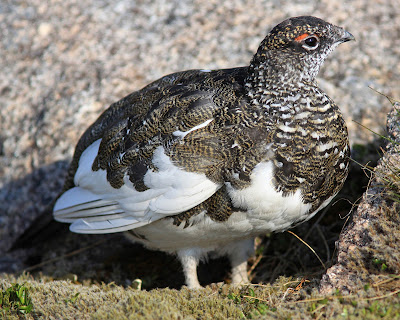Our last full day in Speyside and a very warm one with hot sun right from the word go. A four hour hike around the Inshriach Forest and taking in Loch an Eilein and part of the Rothiemurchus Estate was just reason for visiting a local tea house and sampling some tea and home-made cake! The birds were unremarkable and included several flocks of unidentified Crossbills, Redstart, Tree Pipit, Spotted Flycatcher, Osprey, Common Buzzard, Crested Tit and similar fare. Many small birds were already forming flocks as the earlier broods of tits, Treecreeper and warblers begin their independence and create these super gleaner pockets of birds.
The afternoon was taken up climbing Mount Cairngorm, and once to the summit we took a little wander around the high tops and then clambered down. Ptarmigan showed really well and it seemed were habituated to seeing people on a regular basis. A male Red Grouse seemed to be suffering an identity crisis as it accompanied a female Ptarmigan on the high tops with her brood of young!
Five Ring Ouzels were on the slopes below the summit and a Snow Bunting flew over calling, and we flushed up a Mountain Hare. We arrived back at the car at about 7.30pm and the weather was still hot. Amazingly there was hardly anyone about!
We finished the day with some scanning over Insh Marshes which provided views of regular wildlife but nothing extraordinary.
Eleanor and Neil
 |
| Male Redstart |
 |
| Female Ring Ouzel guiding us to the top of Mt Cairngorm! |
 |
| Female Ptarmigan |
 |
| Ptarmigan chick |
 |
| Male Ptarmigan |














+2nd+July+022+Red+Squirrel.jpg)
+2nd+July+234+Pine+Marten.jpg)




























